12 Best Beginner Telescopes in 2024 [Actually Simple to Use]
Looking for a beginner telescope that’s pretty good but doesn’t cost a fortune? You are in the right place.
Dobsonians offer the most value for money, but most reflectors are great for beginners.
The best beginner telescope has a large aperture, is easy to use, and is reasonably portable.
Best Beginner Telescope
1. Orion SkyQuest XT8 Classic Dobsonian Telescope
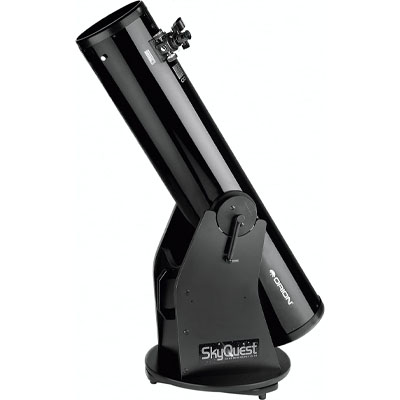
If you want amazing views from a well-priced, large telescope with a huge 8” aperture, the Orion SkyQuest XT8 Dobsonian Telescope is a must-have.
The first look at it is a wow factor – this stunning bright metallic scope stands on the ground and makes for a fabulous selfie. This beginner telescope for adults offers hands down the most value for money.
The base has adjustable altitude tension knobs. The secondary mirror offers a thumbscrew for easy collimation without using tools. The scope comes with 2 eyepieces, a 2″ 28mm DeepView eyepiece and a 1.25″ 10mm Sirius Plossl eyepiece.
It also has a Shorty 2x Barlow lens that doubles the magnification. The EZ Finder II reflex sight and 2″ dual-speed Crayford focuser make it easy to locate and track objects in the sky.
You will notice that the 8″, 205mm diameter parabolic primary mirror collects 78% more light than a 6″ mirror. This gives a significant increase in the ability to observe nebulas, globular star clusters, and to see finer details in fainter galaxies.
It is certainly worth spending a bit more money on the best telescope for beginners that will last a lifetime.
What we liked
- Great value for money
- Eye-catching metallic black optical tube
- Large 203mm aperture that’s best telescope for a beginner
- Redesigned base with adjustable altitude tension knobs
- Convenient thumbscrew-adjustable secondary mirror for easy collimation without tools
- 2 eyepieces, 2” 28mm DeepView eyepiece, 1.25″ 10mm Sirius Plossl Shorty 2x Barlow lens
What we didn’t like
- Large size floor standing scope may not suit all users
- Learning curve to get started with these amateur telescopes
Best features: Large 203mm aperture for amazing views
How it’s beginner friendly: Convenient thumbscrew-adjustable secondary mirror for easy collimation without tools
What can you see with it: More detailed views of Moon, planets, faint galaxies, nebula and star clusters
2. Celestron NexStar 8 SE Telescope
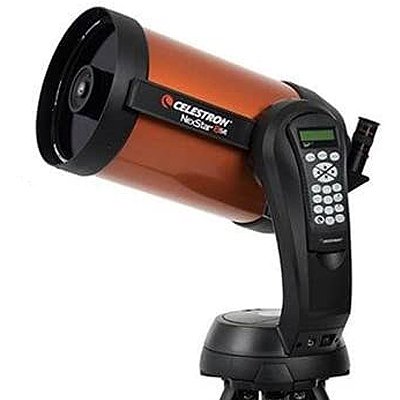
The Celestron NexStar Schmidt Cassegrain 8SE Telescope is a highly advanced top telescope for beginners and more experienced users.
It uses SkyAlign technology to locate and track objects in the sky. Simply point to three bright images and the scope will align to the object you want to view. It comes with a database of over 40,000 celestial objects and you can update it over the Internet.
The scope has an eye-catching orange tube that attracts attention. It has a large 8” aperture for amazing views. This model comes with a 25mm eyepiece and a StarPointer Finderscope. The optics have StarBright XLT enhanced coatings for maximum clarity and light transmission.
All NexStar SE models are GPS compatible and come standard with an auxiliary port for use with additional accessories. You can attach astrophotography equipment for beginners and try your hand at snapping photos of deep-sky objects, a very exciting hobby that will thrill the family.
Set up is fast and easy with a quick-release optical tube and no tools are needed. This is a higher-priced telescope best suited for families who are more familiar with astronomy. It makes a great gift for a young enthusiastic stargazer.
What we liked
- 203mm aperture, 2032mm focal length
- 25mm eyepiece
- SkyAlign for fast and easy alignment process
- Computerized hand control and motorized altazimuth mount
- Alt-Az, EQ North & EQ South Tracking Modes
- The Sky Planetarium software with 10,000 object database
- Great beginner astrophotography telescope
What we didn’t like
- Higher price
- Better suited for more advanced users
- Learning curve to get started
Best features: Large 203mm aperture, computerized mount
How it’s beginner friendly: SkyAlign to easily find and track objects
What can you see with it: Moon, planets, nebula, Messier objects, star clusters
3. Orion SpaceProbe 130ST EQ Reflector Telescope
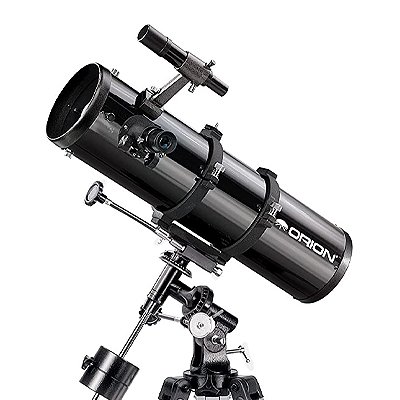
When we set off on a stargazing outing, we look for a telescope that is very portable and the Orion SpaceProbe 130ST is a great choice. It has a shorter length, a 24” optical tube, making it easy to fit into the car.
This best amateur telescope features a 5.1″ aperture, which gathers large amounts of light. We have great views of the Moon and planets, as well as brighter galaxies and remote star clusters. The Orion Spaceprobe 130st is a versatile scope that the whole family enjoys.
It comes with a sturdy EQ-2 equatorial mount that is easy to set up. The adjustable tripod allows manual slow-motion tracking, keeping the image in the eyepiece as it moves across the sky. These amature telescopes come with two 1.25” Sirius Plossl eyepieces, a 25mm and 10mm.
It also has a 6×30 finder scope, a collimation cap, and a handy tripod accessory tray. For added value and better viewing, the 2x Barlow doubles the magnification of these telescopes for beginners and adults. Also included for information with this good beginner telescope is the Star Target Planisphere, MoonMap 260, and Orion Telescope Observer’s Guide Book.
What we liked
- Well priced
- 5.1” aperture for bright views
- 2 1.25” Sirius Plossl eyepieces, 25mm and 10mm.
- Great for viewing the Moon, planets, and star clusters
- Short length 24” optical tube, great for portability
- Top amateur telescope with slow-motion controls for ease of use
- Accessory tray, 6×30 finder scope, Starry Night Astronomy Software
What we didn’t like
- Not computerized
- A few users found the initial set up to be tricky – but this was a minority
- The mount gear tends to get sticky from time to time
Best features: Well priced, 5.1” aperture for bright views
How it’s beginner friendly: Slow-motion controls for ease of use
What can you see with it: Moon, planets, star clusters, Orion Nebula, deep sky objects
4. Sky Watcher 8in. Flextube 200P Collapsible Dobsonian Telescope
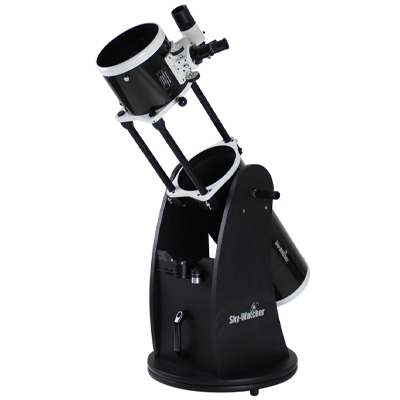
The next beginner telescope that caught our attention is the Sky Watcher 8 in. Flextube 200P Collapsible Dobsonian. Dobsonian design telescopes offer bright, bold views at a fraction of the cost of other optical designs.
This great amateur telescope has an innovative collapsible design that allows the optical tube to collapse for ease of portability. After collapsing, you lock it in place to prevent movement or damage. What we find most amazing is that it keeps its collimation even when closed, and you don’t have to collimate again after opening.
The scope comes with 2 eyepieces, a 25mm and a 10mm. There is also an 8×50 right-angle Finderscope and a 2-inch Crayford-style focuser. The scope has a huge 8” aperture for amazing views. With this size, you can view fainter galaxies and resolve nebula that you cannot see with a smaller aperture.
The fully multi-coated borosilicate primary and secondary mirrors add to the exceptional views. The mount has Teflon bearings that ensure smooth azimuth movement. The tension control handles have a patented design and allow for accurate movement without the need for perfect balance. This telescope for amateur astronomy offers great accuracy and astounding views of the night sky.
What we liked
- 8″ 203mm Dobsonian-style Newtonian
- Innovative collapsible design
- 1200mm focal length
- 2″ Crayford-style focuser with 1.25″ adaptor
- 2 eyepieces, Plossl 25mm and 10mm
- 8×50 right angle erect-image Finderscope
- Solid rocker mount with Teflon bearings and tension clutch
What we didn’t like
- Higher price
- Not computerized
- Learning curve to get started
Best features: 8” wide-angle aperture for great views
How it’s beginner friendly: Innovative collapsible design for portability
What can you see with it: More detailed views of Moon, planets, faint galaxies, nebula, and star clusters
5. Orion StarBlast 62mm Compact Beginner Refractor Telescope
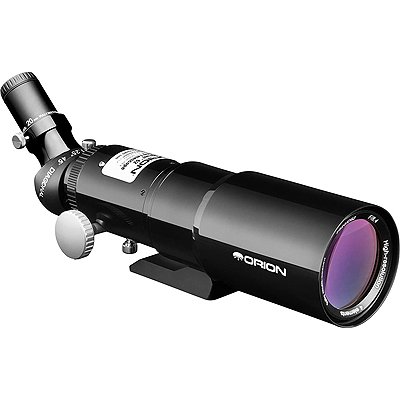
A great beginner telescope, the Orion StarBlast 62mm Compact Beginner Refractor Telescope is perfect for on-the-go stargazers. This lightweight scope at only 3.1 lbs comes in a hard carry case.
It is perfect for packing into a car for a camping trip away from city lights. The scope features a 62mm refractor aperture and a 520mm focal length. The 4-element lens system gives sharp, detailed views of the Moon, planets, and bright deep sky objects. You can also use this amateur telescope for observing animals and birds.
This best refractor telescope for beginners comes with two Plossl eyepieces, a 20mm and a 4mm. It also has an Orion 1.25″ Deluxe 45° Correct-Image Prism Diagonal for easy viewing. The smooth Crayford focuser is simple to use and keeps celestial objects in view without them jumping around.
The only con with this best starter telescope is that it does not come with a mount. It has a narrow Vixen-style dovetail mounting block with a 1/4″-20 threaded socket for attachment to a telescope mount or standard photo tripods. You will need to purchase one to go along with the scope. Kids will love the Starry Night Special Edition astronomy software. It is so helpful to show them how and what to view.
What we liked
- 62mm refractor aperture, 520mm focal length
- Great compact design for beginner astronomy
- Well constructed and really cool looking
- 2 eyepieces, Plossl 20mm and 4mm
- Orion 1.25″ Deluxe 45° Correct-Image Prism Diagonal
- Hard carry case for travel
- Starry Night Special Edition astronomy software
What we didn’t like
- Does not come with a mount
- Best suited for travel, not stay-at-home
- Some users prefer a larger aperture
Best features: Compact, light, and easy to take on a trip
How it’s beginner friendly: Smooth Crayford focuser and helpful Starry Night Special Edition astronomy software
What can you see with it: Moon, planets, star clusters, also terrestrial viewing, birds, animals, ships
6. Celestron NexStar 127SLT Computerized Beginner Telescope
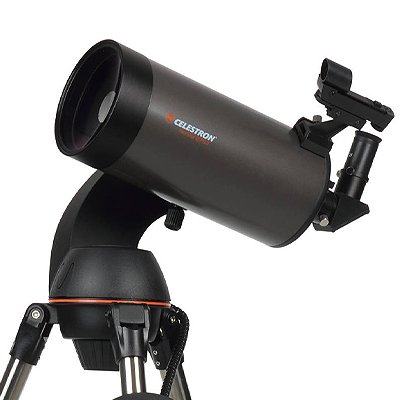
This best amateur telescope is an exciting upgrade, as it is computerized. If you are skeptical to start, remember that teenage kids are on-the-mark when it comes to electronics and will figure it out in no time.
The telescope comes with a database of more than 40,000 stars, galaxies, nebulae, and sky objects to get you started. The great feature is the computerization that allows you to locate your object, and then the scope tracks it for you. No more moving the mount manually and losing the image.
The Celestron NexStar 127SLT comes with a Red Dot StarPointer and 2 eyepieces, a 25mm and a 10mm. It has a sturdy adjustable, full-height steel tripod with an accessory tray to keep your accessories organized.
With a Maksutov-Cassegrain optical design and a 127mm aperture, the Celestron computerized telescope for beginners gives stunning views of the Solar System, craters on the Moon, Saturn’s rings, and Jupiter’s cloud bands.
With a compact design, this is certainly the best telescope for amateur astronomy, ideal for taking along on weekend camping trips.
What we liked
- 127mm aperture for great views
- 2 eyepieces, 25mm and 10mm
- Fast locating of celestial objects with Celestron’s Skyalign
- Top rated telescopes for beginners with computerized mount
- Compact design ideal for travel
- Bonus free Starry Night Software
- Adjustable, full-height steel tripod with accessory tray
What we didn’t like
- Higher price for amateur astronomy
- Learning curve for people not up to speed with computerized scopes
Best features: Computerized, full-size adjustable tripod
How it’s beginner friendly: Fast set up with Skyalign – simply center any three bright objects in the eyepiece and the NexStar SLT aligns to the night sky
What can you see with it: Solar System, craters on the Moon, Saturn’s rings, Jupiter’s cloud bands
7. Orion StarBlast II 4.5 EQ Reflector Beginner Telescope
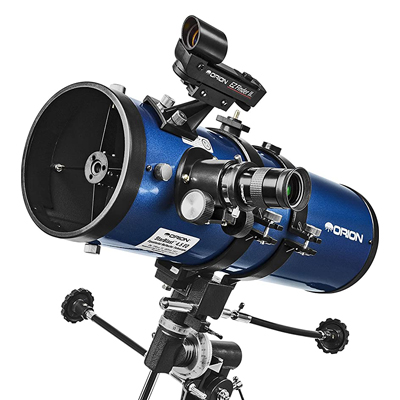
The next beginners telescope for review is the Orion StarBlast II 4.5 EQ Reflector Beginner Telescope. This wide-field reflector telescope has a 4.5 inch aperture giving amazing views of the Moon, planets, Messier objects, and bright deep-sky objects. At a very affordable price, this is a great choice for a family starting out on a stargazing hobby and will last for years to come.
This good starter telescope comes with two eyepieces, a 25mm Sirius Plossl that gives 18x power magnification and a 10mm Sirius Plossl that gives 45x power magnification. It also offers an Orion Shorty 2x Barlow lens that doubles the magnification.
The scope stands on an EQ-1 equatorial telescope mount that is super easy to set up. Kids love the EZ Finder II reflex sight aiming device. Simply point at the object you want and it comes into view. As a bonus, the kit contains a RedBeam Mini Red LED keychain flashlight.
It is ideal for finding accessories and reading in the dark. This kit is also packed with educational information. It comes with an Orion MoonMap 260, Orion Star Target Planisphere, and Orion Telescope Observer’s Guide book.
What we liked
- Well priced best beginner telescopes with great features
- 4.5 inch aperture with great light collecting ability
- 2 eyepieces, Sirius Plossl 25mm, and 10mm
- Orion Shorty 2x Barlow lens
- EQ-1 equatorial telescope mount
- EZ Finder II reflex sight aiming device
- Orion Star Target Planisphere and Orion Telescope Observer’s Guide book
What we didn’t like
- Some users found that the 2x Barlow distorts the images
- A bit heavy for grab-and-go travel
Best features: Great optics for crystal clear views
How it’s beginner friendly: Easy to set up EQ mount, numerous astronomy guides
What can you see with it: Moon, Jupiter’s moons, Saturn’s rings, star clusters
8. Celestron Astro Fi 102 Wi-Fi Maksutov Wireless Reflecting Telescope
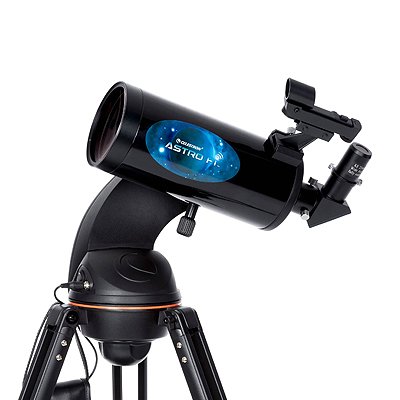
Looking for another Wi-Fi enabled scope, we came across the Celestron Astro Fi 102 Wi-Fi Maksutov Wireless Reflecting Telescope. Kids will love this Celestron beginner telescope because it connects via your smartphone or tablet. You take control of the telescope wirelessly and do not need cell network reception. The free app works with iPhone, iPad, and Android devices.
The telescope has a Maksutov Cassegrain design with a fully coated glass optic 102mm aperture. It comes with two Kellner eyepieces, a 25mm and a 10mm. Also included is a star diagonal and a Finderscope for easy locating of sky objects.
The tripod is adjustable, great for families with smaller kids. It has a handy accessory tray for holding all your bits and pieces. The scope automatically tracks objects with a slew speed of up to 3 degrees per second. Just sit back, relax, and follow the object as it moves across the sky.
The set up of this scope does not require tools, ideal for people like me who are not great with DIY projects. With it, you will see amazing views of the Moon’s craters, Saturn’s rings, nebula, and star clusters. The battery lasts for hours without you worrying about running out of power. For techno-savvy users, the App includes star maps and support for gamepads.
What we liked
- Has integrated WiFi using the free Celestron SkyPortal app
- Computerized mount on this best beginner goto telescope
- Works with iPhone, iPad, and Android devices
- 102mm aperture
- 2 eyepieces, a 25mm and a 10mm
- Star diagonal and Finderscope
- No tools needed for easy set up
What we didn’t like
- Some users may prefer a non-computerized option
- Must know your way around apps
Best features: Integrated WiFi, works with h iPhone, iPad, and Android devices
How it’s beginner friendly: Tech-savvy kids will love this
What can you see with it: Saturn rings, Moon, Ice caps on Mars, Jupiter’s moons, star clusters, nebula
9. Celestron AstroMaster 130 EQ Equatorial Reflector Telescope
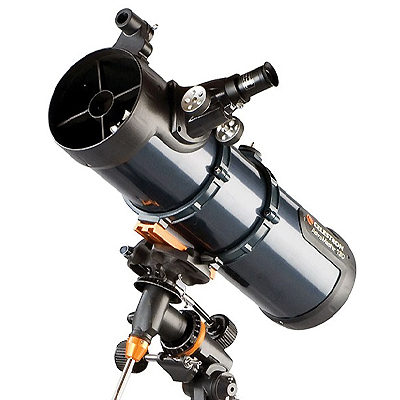
The Celestron AstroMaster 130 EQ Equatorial Reflector Telescope is ideal for both terrestrial and celestial viewing. You can take it along on a safari trip and have great fun viewing animals and birds in their natural habitat. And, of course, we all love an easy-to-use telescope that gives great views of the Moon, planets and star clusters, and far-away nebulas.
The starter telescope features a 130mm aperture and a 650mm focal length. It comes with 2 eyepieces, a 20mm and a 10mm, with 50x and 100x magnification, respectively. The EQ mount allows us to follow objects with ease.
It uses a set of counterweights to balance the telescope as it moves, making each movement more smooth. These best amateur telescopes have a pre-assembled tripod with 1.25″ thick steel legs, offering a rigid and stable platform. It also has a deluxe accessory tray for convenient storage of all your accessories.
What we liked
- Dual-purpose, ideal for terrestrial and celestial viewing
- All-coated glass optics
- Permanently mounted StarPointer
- EQ mount for smooth and accurate control
- Pre-assembled tripod with 1.25″ steel legs
- Deluxe accessory tray for convenient storage
- The Sky” Level 1 planetarium software with 10,000 object database
What we didn’t like
- Some users wanted better quality – this is a cheaper scope
Best features: Good price, easy to assemble
How it’s beginner friendly: EQ mount for smooth and accurate control
What can you see with it: Celestial and terrestrial viewing
10. Celestron Omni XLT 150mm Telescope

The next good telescope for beginners we review is the Celestron Omni XLT 150mm Telescope. I find that Celestron is one of the best telescope brands for beginners.
The scope has a Newtonian Reflector Optical Tube, with hand-selected glass. Every air-to-glass surface is fully multi-coated with StarBright XLT anti-reflective coatings. It does make a great difference, and you will see amazing clear views. For ease of use, the mount is an ultra-precise German CG-4 manual EQ mount that is smooth and simple to operate.
The Celestron Omni XLT has a 150mm aperture and a 750mm focal length. It comes with one 25mm eyepiece, 6×30 optical Finderscope, and a 1.25” Star Diagonal. The Stainless Steel tripod is heavy-duty and comes pre-assembled. This amateur astronomy telescope has a handy accessory tray and bubble level for correct leveling.
With a database of 10,000 celestial objects in the Sky Level 1 planetarium software, a family will soon become very adept at finding objects to look at using this telescope for beginners. Enjoy seeing Saturn’s rings, Jupiter’s moon, and polar ice caps on Mars.
What we liked
- 150mm aperture, 750mm focal length
- High-quality, hand-selected optical glass
- Ultra-precise German CG-4 manual EQ mount
- 25mm eyepiece, 6×30 optical Finderscope, 1.25” Star Diagonal
- Ball bearings in both axis of the mount for smooth performance
- Easy setup with no tools required
- Astronomy for beginners Sky Level 1 planetarium Software with 10,000
What we didn’t like
- Higher price
- Only one eyepiece
- Not computerized
Best features: Easy no-tool assembly, high-quality glass optics
How it’s beginner friendly: CG-4 German Equatorial Mount with slow motion controls to easily locate and track objects
What can you see with it: Moon, Saturn’s rings, Jupiter’s moon, polar ice caps on Mars
11. Celestron PowerSeeker 80EQ Refractor Telescope

The Celestron PowerSeeker 80EQ Refractor Telescope is a cheaper, smaller scope, ideal to get as a starter to introduce the family to beginners astronomy. It is ideal for looking at the Moon, Saturn’s rings, Jupiter’s moons and is also great for terrestrial viewing. Take it along to stargaze and watch ships on the horizon on your seaside vacation.
In the sky, you will see Moon craters, Mars, Saturn, and Jupiter. You can also view far-away nebula and star clusters. The scope has an 80mm aperture and a 900mm focal length. It comes with 2 eyepieces, a 20mm with 45x power magnification and a 4mm with 225x power magnification. It also has a 3x Barlow Lens, which triples the magnification.
The kit needs no tool for set-up and can even be done by the kids. Fully coated glass optical components give enhanced image brightness and clarity. The mount is an equatorial mount with a motorized drive that reduces the amount of bumping and shaking while focusing.
This best beginners telescope has an accessory tray for convenient storage of accessories. For added value, the bonus astronomy software guide has a database of 10,000 celestial objects. There are also printable maps that kids can use for finding sky objects.
What we liked
- Low price good telescopes for beginners
- Quick and easy no-tool setup
- Slow motion controls for smooth tracking
- Great for terrestrial and astronomical use
- 2 eyepieces, 20mm and 4mm, 3x Barlow lens
- Equatorial mount with motorized drive
- TheSkyX – First Light Edition astronomy software
What we didn’t like
- May be too simple for more advanced users
- Not computerized
Best features: Great price, easy no-tool setup
How it’s beginner friendly: EQ motorized mount, no shaking or bumping when viewing
What can you see with it: Celestial and terrestrial viewing
12. Orion StarBlast 6 Astro Reflector Amateur Telescope
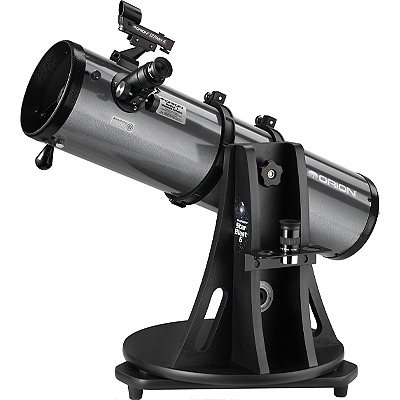
My wife enjoys a tabletop mount. She doesn’t have to worry about the dogs knocking it over! The Orion StarBlast 6 Astro Reflector Amateur Telescope Kit offers a fabulous, simple point-and-view telescope kit. It is great for both beginners and seasoned astronomers, with ease of use and versatility.
As a good amateur telescope, it features a large 6″ aperture. We enjoy viewing the craters on the Moon, planets, star clusters, and Messier objects. It has a compact pre-assembled design, which means no struggling to get it set up. It is ideal for grab-and-go portability for a weekend trip away from city lights.
This great beginner telescope comes with 2 eyepieces, a Sirius Plossl 25mm and a 10mm. It has an EZ Finder II reflex sight for easy locating of any celestial object. For great Moon views, we use the 13% Transmission Moon Filter to enhance the images.
There is also a Shorty Barlow Lens that doubles the magnification of the lenses. In the kit is a fun RedBeam Mini Red LED keychain flashlight, ideal for reading the sky maps in the dark. The Starry Night Special Edition astronomy software and Star Target Planisphere are awesome to guide stargazing for beginners.
What we liked
- Great value for money entry-level telescope
- 6″ aperture, 750mm focal length
- 2 eyepieces, Sirius Plossl 25mm, and 10mm
- Orion Shorty 2x Barlow lens
- Tabletop mount for easy use
- RedBeam Mini Red LED keychain flashlight
- Red Dot EZ Finder II
What we didn’t like
- Some users prefer a hobby telescope with a floor-standing mount
- Focuser could be better
Best features: Table top mount for ease of use
How it’s beginner friendly: Red Dot EZ Finder II to easily locate objects
What can you see with it: Moon, Jupiter’s moons, Saturn’s rings, star clusters
Types of Telescopes
Refractor
Refractor telescopes feature a design made only of lenses. This results in a lighter weight and more portable model. Refractor telescopes are the best beginner telescope for planets and the moon as they offer amazing sharpness, clarity, and contrast of view.
Because the tube is closed, the telescope is protected against humidity and dust. There is almost no maintenance or cleaning needed.
On the con side, there may be chromatic aberrations on the images. This is a distortion that occurs on the edges of the image you are viewing. Refractor telescopes are usually more expensive than reflector telescopes.
Reflector
Reflector telescopes have a construction composed of mirrors. The large mirrors offer a greater degree of light collecting capacity. There are no chromatic aberrations and no colored fringes around objects that you view.
Reflector telescopes are ideal for viewing deep-sky objects like galaxies, messier objects, and star clusters. The simpler design of a reflector telescope results in a lower-cost best first telescope option for amateur stargazers.
On the negative side, the optical quality can sometimes be disappointing. You do need to clean the mirrors for best viewing. The open tube design can be adversely affected by dust and humidity. Reflector telescopes are generally bulkier than refractors.
Catadioptric / Compound / Cassegrain
The terminology Catadioptric / Compound / Cassegrain refers to a design that uses a combination of a primary concave mirror and a secondary convex mirror. The design gives a folded optical path that reduces the size of the telescope. These telescopes are lighter and easier to transport. The combination of a lens and a mirror gives a greater degree of error correction with distortion of images.
How to Choose the Best Telescope for Beginners?
Aperture
Depending on your budget, apertures can range from a smaller 80mm to a large 203mm. The larger the aperture, the more it will cost and the better views you will get.
Magnification
Magnifications pertain to the eyepieces. Some telescopes come with more than one eyepiece, offering a choice of magnifications. Power magnifications can be anything from 20x to 40x or more.
Higher magnification does not always mean a better image, as huge images tend to become distorted. Many best telescopes for beginners come with Barlow lenses. These lenses can double or triple the magnification.
Field of view
This is the amount of sky you see in your lens. Larger, more expensive scopes have a larger field of view. Values range from 1° to 3° on amateur telescopes.
Focal length
The focal length is effectively the length of the telescope. Focal lengths on best amateur telescopes can vary from 600mm to 1200mm and greater. The longer the focal length, the better. Look for 800mm to 1500mm as a starting point.
Focal ratio
This is the ‘speed’ of a telescope’s optics. It is calculated by dividing the focal length by the aperture. The smaller the answer, the lower the magnification will be, and the brighter the image. You don’t need to worry about the focal ratio, as an astronomy telescope for beginners usually provides the best combination of focal length and aperture for price and value.
Mount
Most mounts are hand controlled. Look for mounts with slow-motion controls that make it easier to locate objects. Computerized mounts cost more but give you the added perk of automatically tracking an object for you across the sky.
Electronic controls
These are a plus if you are going to do serious stargazing. They automatically locate and track objects, saving you from doing the work manually.
Eyepieces
Will vary in size from 4mm to 25mm. Different eyepieces give different magnifications. A telescope that comes with more than one eyepiece is a better choice as you have variety.
FAQ
What is the best telescope for beginners?
The Orion SpaceProbe 130ST EQ Reflector Telescope is a great choice. It has a shorter length 24” optical tube and a large 5.1″ aperture. It comes with a sturdy EQ-2 equatorial mount that is easy to set up. Also included are two Sirius Plossl eyepieces and a 2x Barlow.
What is the best telescope to buy for a beginner?
Another great choice for a beginner is the Orion StarBlast 6 Astro Reflector Amateur Telescope Kit. It stands on a table-top and is easy to use. The scope offers great value for money with a large 6″ aperture. It comes with 2 eyepieces, a Sirius Plossl 25mm and a 10mm.
What can I see with a beginner telescope?
You will see craters on the Moon, Jupiter’s moons, Saturn’s rings, and polar ice caps on Mars. You can also view deep sky objects like star clusters, nebulas, Messier objects, and fainter galaxies. Some telescopes for beginners are also great for terrestrial viewing.
How to use a telescope for beginners?
The best option is to get a light, portable telescope that you can take along on an outing away from city lights. Set it up and make use of the included astronomy Star Maps and other related info. Find and locate the object and track it as it moves across the sky.
How much should I spend on a telescope?
You can find cheaper telescopes at under $200. For a better and longer- lasting option look for telescopes that cost between $300 to $600. If your family is serious about stargazing, a best beginner telescope for adults will cost up to $1000 for a lifetime investment.
How do I choose my first telescope?
Decide on your budget and look for the most features you can get for the money. Find a telescope with the largest aperture and more than one eyepiece. If you can afford a computerized mount and are used to working with mobile apps, this is a great way to start.

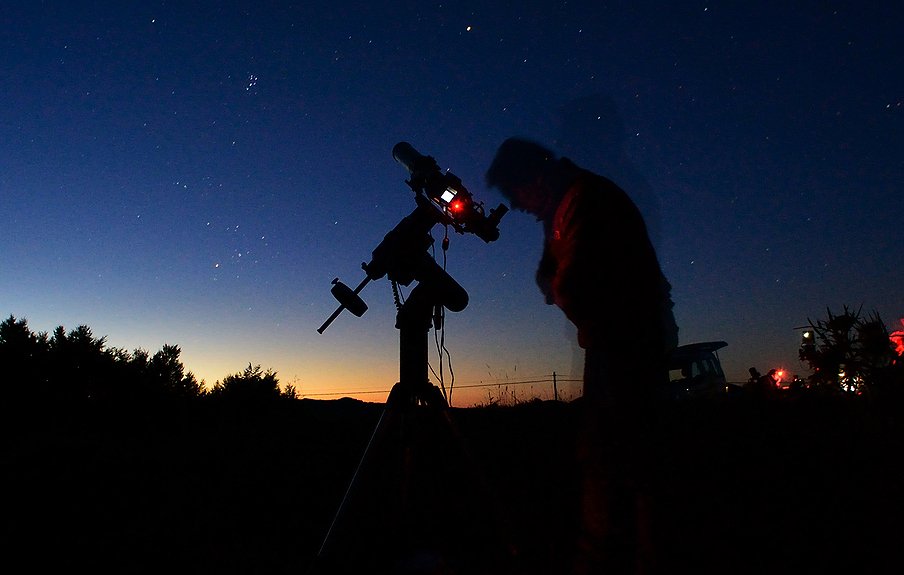
![12 Best Telescopes for Kids in 2024 [Toddlers to Teens]](https://www.planetguide.net/wp-content/uploads/2019/12/Depositphotos_2254021_l-2015-768x512.jpg)
![12 Best Refractor Telescopes Actually Worth the Money [2024]](https://www.planetguide.net/wp-content/uploads/2019/12/refreactor-telescope-768x461.jpg)
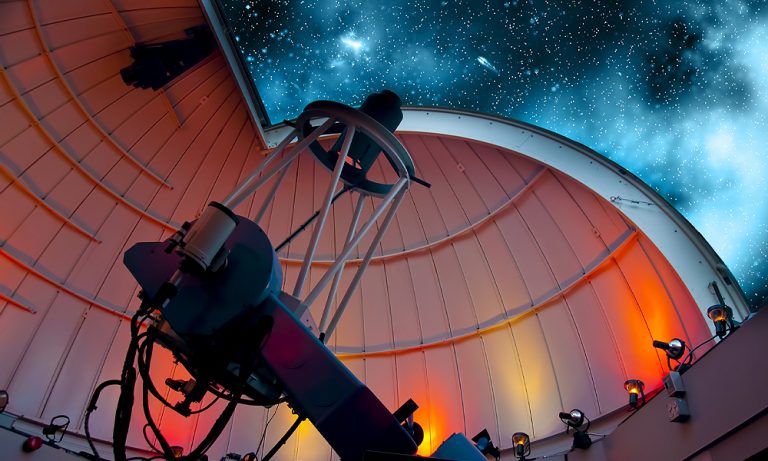
![12 Best Telescopes for Viewing Planets and Galaxies [2024]](https://www.planetguide.net/wp-content/uploads/2019/12/Depositphotos_144986289_l-2015-768x512.jpg)
![12 Best Travel Telescopes in 2024 [Portable & Durable]](https://www.planetguide.net/wp-content/uploads/2019/12/best-travel-telescope-768x461.jpg)